

Why We Need to See Each Other Teach. New ways of thinking about classroom observation and feedback. Late last year, Principal Christine Cawsey AM and Dr Tony Loughland of UNSW wrote an article that discussed five key questions around observing a class and giving instructive feedback.

They argued that there is a growing professional and academic understanding of the use of classroom observation and feedback as key tools for improving the quality of teaching and learning practice for individual teachers, teams and schools. In today’s second instalment, they return to the questions to share their responses on the last three. The five key questions on classroom observation What professional learning do supervisors and school teams need to improve practice in student, self, peer and supervisor observation in the school? How do observers address their own biases and build the consistency of observer judgement across the school? In our first article, we posited answers to the first two questions based on our professional and academic study.
New ways of thinking about observation References. 5 Tips To Transition From Teacher To Coach. When I first started working as an instructional coach, it was hard to settle into my role on the periphery of the classroom.
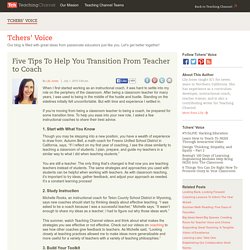
After being a classroom teacher for many years, I was used to being in the middle of the hustle and bustle. Standing on the sidelines initially felt uncomfortable. Teachingchannel. Easing the Stress of Evaluations for Administrators. My previous post explored making summative evaluations less stressful for teachers.

Now we move to the other side of the table, starting with a cautionary (and unfortunately true) tale. The Administrator's Nightmare "Uh, well, you had a good first year, right? " I asked awkwardly. "It was OK. " "Let's get started. The teacher was immediately defensive. I replied, "I noticed that you made some effort to control the extra talking, such as proximity and redirection. The teacher responded with sarcasm. No, this wasn't going well, but I plunged ahead anyway. "No, why don't you tell me what you would have done? " As delicately as possible, I asked, "Have you tried anticipating their behavior and building learning activities targeted to reduce the behavior into the lesson?
" The teacher folded his arms. Not willing to concur, I pressed on. The teacher bristled. Taken aback, I responded, "Well. . . "That’s just great! " "A remediation plan? Classroom Observation Strategies. Classroom observation makes teaching and learning more visible.
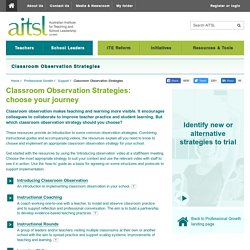
It encourages colleagues to collaborate to improve teacher practice and student learning. But which classroom observation strategy should you choose? These resources provide an introduction to some common observation strategies. Combining instructional guides and accompanying videos, the resources explain all you need to know to choose and implement an appropriate classroom observation strategy for your school. Get started with the resources by using the ‘Introducing observation’ video at a staff/team meeting. Teacher spends two days as a student and is shocked at what she learns. A student takes notes at Woodrow Wilson High School in Washington D.C.
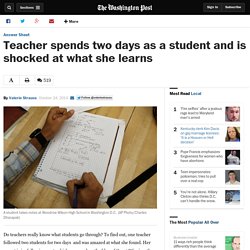
(AP Photo/Charles Dharapak) Do teachers really know what students go through? To find out, one teacher followed two students for two days and was amazed at what she found. Her report is in following post, which appeared on the blog of Grant Wiggins, the co-author of “Understanding by Design” and the author of “Educative Assessment” and numerous articles on education. A high school teacher for 14 years, he is now the president of Authentic Education, in Hopewell, New Jersey, which provides professional development and other services to schools aimed at improving student learning. Wiggins initially posted the piece without revealing the author. By Alexis Wiggins. Innovative Teaching Coaching Models. Takeaways From a Video Coaching Experiment. You know the expression “two heads are better than one?”
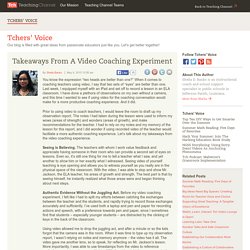
When it comes to coaching teachers using video, I say that two sets of “eyes” are better than one. Last week, I equipped myself with an iPad and set off to record a lesson in an ELA classroom. I have done a plethora of observations on my own without a camera, and this time I wanted to see if using video for the coaching conversation would make for a more productive coaching experience. And it did. Prior to using video to coach teachers, I would leave the room to draft up my observation report. Seeing is Believing. Authentic Evidence Without the Juggling Act.
Using video allowed me to drop the juggling act, and after a minute or so the kids forgot that the camera was in the room. No Hassle, No Fuss. In short, the “experiment” with coaching using video was a hit, and this is my new way of coaching teachers from here on out. Educational Coach's Toolkit: 3 Ways To Take Observational Notes. Last week, I had the opportunity to participate in a brainstorming session with other coaches where we talked about our successes and challenges around observational coaching.
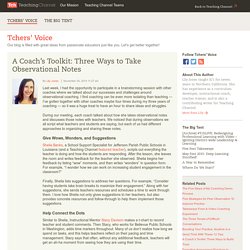
I find coaching can be even more isolating than teaching — I’ve gotten together with other coaches maybe four times during my three years of coaching — so it was a huge treat to have an hour to share ideas and struggles. During our meeting, each coach talked about how she takes observational notes and discusses those notes with teachers. We noticed that during observations we all script what teachers and students are saying, but each of us had different approaches to organizing and sharing these notes. Give Wows, Wonders, and Suggestions Shelia Banks, a School Support Specialist for Jefferson Parish Public Schools in Louisiana (and a Teaching Channel featured teacher), scripts out everything the teacher is doing and how the students are responding. Innovative Teaching Coaching Models. 7 Ways School Leaders Can Use Teacher Observations More Effectively. 7 Ways School Leaders Can Use Observations More Effectively by Paul Moss Whilst observations are certainly not the whole picture of a teacher’s skill, they can provide excellent opportunities for teachers to reflect on their practice.
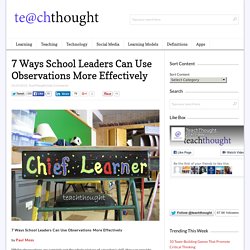
If my last article How Your Teacher Observation Can Help You Grow convinced teachers of the benefits of observations, the onus is now placed on school leaders to provide the necessary conditions for such a culture to survive, and thrive. The key word here is culture. How Your Teacher Observation Can Help You Grow. How Your Teacher Observation Can Help You Grow by Paul Moss For many, teacher observations are their biggest source of dread.

They stir feelings of nausea, spark vigorous and often angry debate about their efficacy, and are to be avoided at all costs. But with the trend of performance pay sliding into the education environment like a rattlesnake, the fear of observations has some very real and legitimate origins. No one wants to lose his or her job, or his or her pay rise.